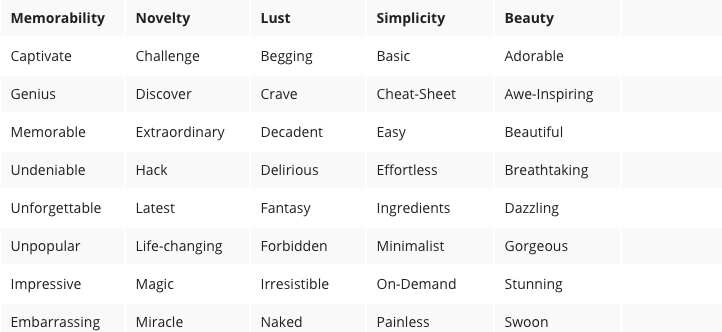What’s the formula for a winning online course title? In this post, we researched by looking to some of the biggest experts out there in online course creation.
What’s the best way to fit a lime into a Corona?
With a little twist.
And when you’re thinking of a course title, you’re always thinking – how can I give this a little twist?
Everyone wants to be clever.
Some experts say this can be good in a course title. Others say it can be confusing.
There’s a lot of conflicting advice out there on how to create a great course title. And people spend way too much time on it.
For this post, we looked to five experts to lead the charge on course titles.
In our research, we looked for uniqueness and ease of applicability, since there’s a lot of recycled advice out there.
Don’t try to use every tip in this post – you might overwhelm yourself and further stymie your progress.
But pick and choose a few that work for you, and form your own process for course title creation.
Make it Easy to Remember and Use Audience Keywords (Amy Porterfield)
The first expert advice on creating a title for your online course comes from Amy Porterfield. Amy recommends spending no more than a week coming up with your course name. She says:
“Your goal is to choose a name so that you can move on to the more important decisions and actions that will create life-changing impact in your business and the people you serve.”
A lot of other experts agree. Business launch expert Till Boadella even goes so far as to say you don’t want to spend more than five minutes on your course name (although that’s a bit of a stretch to me!).
There are a few things Amy recommends keeping in mind when coming up with your course name, and those are:
- Make it easy to remember.
- Make it easy to say out loud.
- Use keywords your audience will recognize.
- Make it interesting.
- Make sure it’s not too creative (you shouldn’t have to repeatedly explain what it means).
- Make sure your ideal customer knows what it’s about, right off the bat.
Inside her online course Digital Course Academy, she offers a few examples of great course titles and divides them up into categories.
Here are a few examples to help get your creative juices flowing:
Title Type: It Is What It Says It Is
Examples: Weight Loss for Busy Physicians, Uber Driving Academy
Title Type: The Signature, Proprietary System
Examples: Food Photography School, Product Launch Formula
Title Type: Result in the Title
Examples: Live More, Weigh Less, Double Your Dating
To ease some of the pressure, remember you can always use subtitles in your online course name to help clarify your title, or to add anything that you couldn’t put into the main title.
For example, Amy has a webinar course titled Webinars That Convert. She has a great subtitle to go along with it.
The complete A-Z blueprint for creating and delivering high-converting webinar funnels that flood your list full of raving fans, build massive trust and value, and quickly put your scaled-up profits on autopilot.
Don’t overthink it – if you make a mistake in your title, you’ll know as you move forward.
I also like this image from the kind people at Content Sparks. It gives an at-a-glance look at what you should be thinking about for your course name. Especially if you’re feeling scattered in your brainstorming.
Image from Content Sparks
Let Your Product Differentiation Guide Your Course Title (Thrive Themes)
This next bit of course naming advice comes from Shane Melaugh of Thrive Themes. He created an online course called Course Craft on how to create an online course (superior course, BTW).
Shane doesn’t specifically talk about how to name your course in Course Craft.
But his ideas on differentiating your online course from all of the others can really help guide you as you brainstorm how to create a great course title.
Here are three ways you can differentiate your course (you don’t have to use all three):
- Identify your specific audience. What makes your online course different is that you’re targeting specific people. You aren’t just targeting entrepreneurs – you’re targeting entrepreneurs in the finance space. You aren’t just targeting pet lovers – but small dog pet lovers. Lock this down, and use it to guide your course naming process.
- Figure out how your way is better. Your course is different in a very specific way. You’re not just teaching gardening, but in a new, better way no one has ever seen before. Or maybe you’re teaching productivity in a new way that teaches people to be more productive by doing fewer tasks. Whatever it is, keep this in mind when brainstorming your title. It may lead you to a great subtitle, too!
- Identify how your course is not like others. When you pinpoint how your course is different from others, you’re on your way to a killer course title. Instead of “How to Build an Email List of 1,000 Subscribers”, maybe you’re offering “How to Build a Subscriber List on Auto-Pilot”. When you know how your course is different, you can use it to create a catchy course title that’s more enticing.
Use the Crowded Bar Technique (LMSCast)
The guys over at LMScast, a podcast on how to generate income and impact with online education, discussed a unique way to settle on a course title.
It’s called the Crowded Bar Technique.
The idea is that you pretend you’re in a loud, crowded bar. If someone at the bar asked you what the name of your course was, would they understand it in that setting, right off the bat?
Would it be instantly clear to them what your course was about and who it was for? Would they remember it the next day, after the vodka sodas wore off?
Thought of this way, it might be best to keep it short and simple, which isn’t always bad.
BitDegree published a lengthy guide on course creation, and in their section on course titles, they say, “Good writing means coming up with title ideas that plainly tell your students what will they learn.”
I like the idea of plain and simple. It might seem basic, but sometimes basic is necessary to sell.
Sprinkle in Some Power Words in Your Course Title (Sumo)
A lot of experts out there talk about the power of using persuasive words in your product names.
Amy Porterfield includes a list in her Digital Course Academy course, and Jon Morrow of Smart Blogger has a lengthy list I’ve bookmarked and referenced for months.
But I really like the advice on power words from Sumo.
Sumo says when naming your online products, you can either be boring or pack a punch.
I vote there’s nothing wrong with boring if it’s clear to your audience.
But if you do want to “pack a punch”, I’d start with boring and sprinkle in some of the power words they recommend.
Here’s a snippet from their site:
Image from Sumo
Here are also a few examples of before and after online course names I drummed up to give you a taste of how you can use power words to add in some spice.
I’ve underlined the power words for reference.
Before: How to Create an Online Course
After: The Step-by-Step Method for Creating an Instantly Profitable Online Course
Before: Self-Care for Women
After: Guilt-Free Self-Care for Moms
Before: Grow Your T-Shirt Business
After: Triple Your T-Shirt Sales Online
A great tool to get your course name juices flowing is also a course name generator I stumbled upon by Julian Rosenblum.
I like this because you don’t have to put anything into it, it just spits out different course titles for inspiration. You can replace some of the titles it generates with your own ideas and work from there.
I do this often with a blog title generator, too – it works great when your brain is completely tapped out.
Make Your Course Title Targeted, Results-Oriented, and Unambiguous (Podia)
Podia, an online course platform, has some additional ideas on how to pick a great course title.
After reviewing thousands of course titles in their platform, they settled on three things all of the most successful courses had in common. Each title was:
- Targeted
- Results-oriented
- Unambiguous
In order to create a targeted course name, they recommend getting to know the language your audience would be most attracted to.
For instance, they said rather than creating a course called Knife Skills, to use more targeted language like Knife Skills to Cut With Confidence.
We can assume their audience doesn’t feel confident in their knife skills, so the words “cut with confidence” are likely to draw in people who are a little nervous using knives.
For a results-oriented course name, put the result in your course title. Instead of “Get More Followers on Instagram”, say “Get 5,000 Followers on Instagram”. That one would be good with a bit more specificity, too. For example, “Get 5,000 Followers on Instagram in 30 Days”.
And lastly, to make your course title unambiguous, you have to make it clear off the bat. They recommend something like “Build Your Freelance Business” over “Find Your Freedom”. You don’t want students thinking twice about what anything means.
Don’t Spend Too Long on Your Course Title – You’ve Got More Important Things to Do
You can spend way too much time trying to figure out your course title. Don't.
There's more important things to do, like creating your course content!
Till Boadella, the business launch expert we mentioned earlier, suggests that instead of becoming obsessed about what to name your course, you should be obsessed with communicating the value and explaining the result of the course.
You can also spend way too much time researching your great course title.
Shane from Thrive Themes calls this being a “research junkie” – where you spend so much time researching you don’t have to do the actual work.
Don’t fall into the procrastination trap, it doesn’t serve anyone.
Here’s a recap of the tips we discussed today, so you can pick the ones that will help you most and get the job done.
- Make your course title easy to remember and use keywords your audience will recognize.
- When brainstorming, figure out how your product is different, and let that differentiation guide you.
- Would someone in a crowded bar instantly know what your course was about and who it was for? Use this Crowded Bar technique to test your title.
- Sprinkle in some power words like profit, instantly, and guilt-free to make your audience feel something and move forward to learn more.
- Make sure your course title is targeted to your ideal audience, results-oriented, and unambiguous so people know what it is.
Your final step here is to let me know how you’re going to move forward. Will you be using any of these tips to create your course title? Or did you use them in the past to create a winning title you’d like to share?
Let me know in the comments!
Till next time, friends.
Monique








